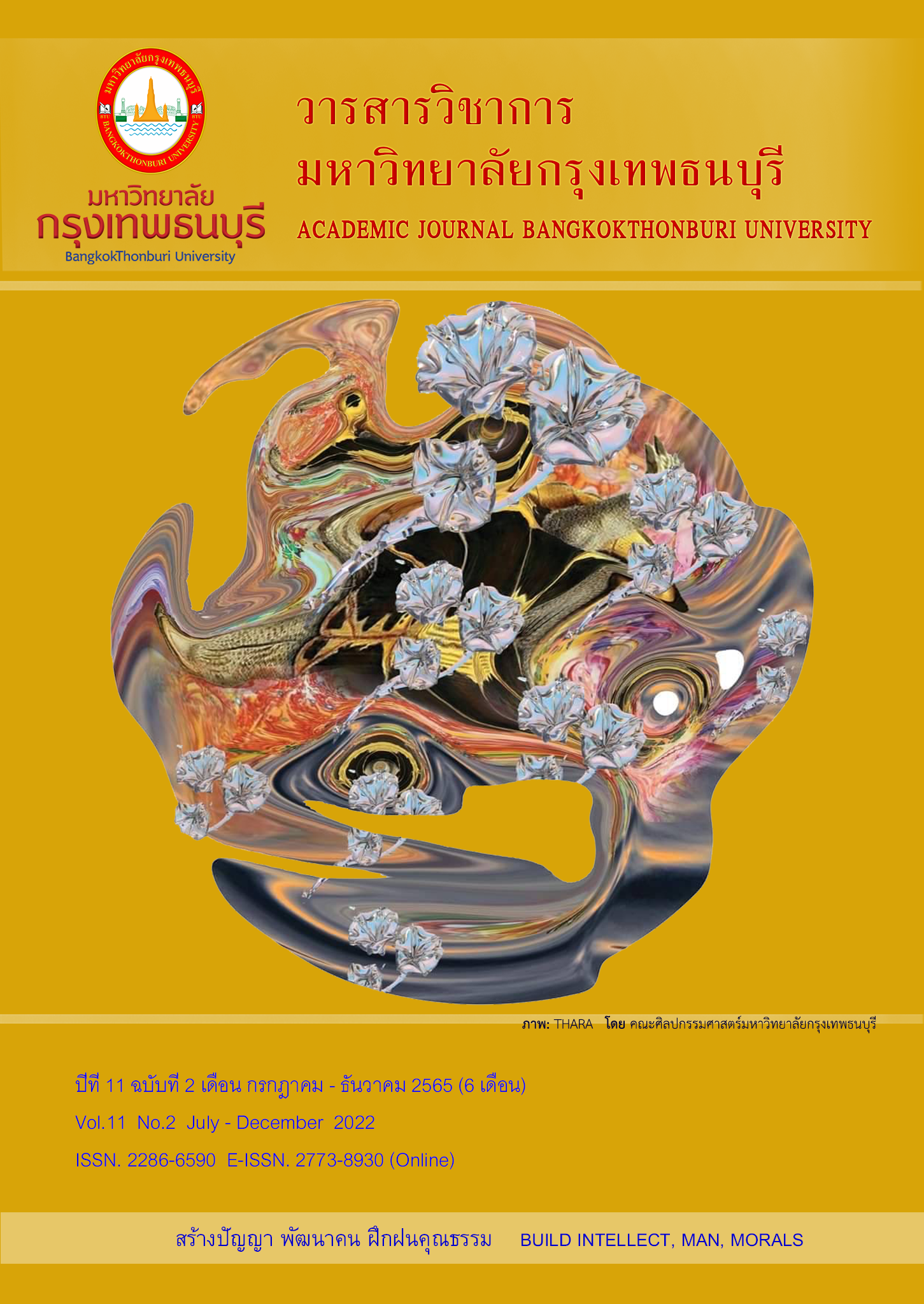The Influence of Purchasing Decisions on Social Media Affecting Brand Loyalty among Consumers in the Central Region of Thailand
Main Article Content
Abstract
The study titled the influence of purchasing decisions on social media affects brand loyalty among consumers in the central region of Thailand. The objective was to study the level of influence factors, their influence on decision-making, and the guidelines for determining appropriate marketing strategies that affect purchasing decisions on social media. The sample group includes people residing in the central region out of 400 people who have engaged in accidental sampling and online shopping in the past three months. The research results found that social media application was at a high level, that is, using social media on smartphones, consumer behavior in the digital age is at a high level, as the perception of marketing media in social media is faster than in other media, such as TV, attitudes about online marketing are at the highest level, online marketing makes them perceive fashionable information faster than offline marketing, the decision to buy products on social media is at the highest level when the price is reasonable, and brand loyalty is at a high level; the first order is confidence in the brand's reputation. Hypothesis test results: The proposed model's goodness of fit index value was c2/df = 1.62, SRMR = 0.07, CFI = 0.91, NFI = 0.91, GFI = 0.95, and RMSEA = 0.04, which was empirically consistent. The recommendation for this research is that the communication between the seller and the buyer must be correct, precise, and quick to represent care, customer empathy, virtue, not deceive consumers, care like part of the family, help attract customers or consumers, pay attention, and commitment to the continuous purchase of goods and services.
Article Details

This work is licensed under a Creative Commons Attribution-NonCommercial-NoDerivatives 4.0 International License.
References
เกษม พิพัฒน์เสรีธรรม. (2547). OTOP นักสู้ชาวบ้าน-นักการตลาดชุมชน. กรุงเทพ: เอ.อาร์. บิซิเนส เพรส, บจก.
ชัยสิทธิ์ เจริญวงศ์วิวัฒน์. (2559). กลยุทธ์การสื่อสารการตลาดดิจิทัล กรณีศึกษา บริษัท สยามแม็คโคร จำกัด(มหาชน). การค้นคว้าอิสระหลักสูตรนิเทศศาสตรมหาบัณฑิต สาขาวิชาการสื่อสารการตลาดดิจิทัล, มหาวิทยาลัยกรุงเทพ.
ณรงค์ยศ มหิทธิวาณิชชา. (2561). อัพเดทตัวเลขและพฤติกรรมผู้ใช้งานสื่อ digital ในเมืองไทย Q3 2018. สืบค้น 5 มีนาคม 2563, จาก https://www.twfdigital.com/blog/2018/07/q3-2018-digital-usage-stats-thailand/
เดชา โควเอี่ยมไพโรจน์. (2561). พลิกโมเดลธุรกิจด้วยดิจิตอล: Transforming to a Digital Business. กรุงเทพ: DECHA.K.
ธีรพันธ์ โล่ทองคำ. (2563). การตลาด 2020 ถึงเวลานักการตลาดต้องเปลี่ยนความคิดกันแล้ว. สืบค้น 10 มีนาคม 2563, จาก https://marketeeronline.co/archives/145679. 2020.
ปณิดดา เกษมจันทโชติ. (2563). เทคนิคชิงหัวใจ 'ผู้บริโภค' ออนไลน์ 2020. สืบค้น 10 มีนาคม 2563, จาก https://www.bangkokbiznews.com/news/detail/868476.2563
ผู้จัดการออนไลน์. (2563). ยังไม่นับ COVID! ปี 62 คนไทยใช้อินเทอร์เน็ตเพิ่มขึ้นเฉลี่ย 10 ชั่วโมง 22 นาที. สืบค้น 5 มีนาคม 2563, จาก https://mgronline.com/cyberbiz/detail/9630000032797
พจน์ ใจชาญสุขกิจ. (2563). ความภักดีในแบรนด์ หรือ Brand loyalty เกิดขึ้นได้อย่างไร. สืบค้น 3 มีนาคม 2563, จาก http://www.drphot.com/talk/archives/2593
พัฐรัศมิ์ ว่องไชยกุล, ศิริลักษณ์ หาพันธ์นา และชานนท์ คล่องแคล่ว. (2563). เปิดสถิติโซเชียล ปี 2019 ที่ไม่ได้มีแค่ด้าน ‘ดี’ แต่ด้าน ‘มืด’ ก็เริ่มชัด. สืบค้น 3 มีนาคม 2563, จาก https://positioningmag.com/1266288. 2020
รัฐวิทย์ ทองภักดี. (2561). 7P’s Marketing Mix กลยุทธ์เด็ดพิชิต "ธุรกิจร้านอาหาร”. สืบค้น 5 มีนาคม 2563, จาก https://www.smethailandclub.com/marketing-2188-id.html
วรวิสุทธิ์ ภิญโญยาง. (2556). Marketing Ideas ไอเดียการตลาดพลิกโลก. กรุงเทพมหานคร: Nation Books.
ศิริชัย แสงสุวรรณ. (2559). พฤติกรรมการใช้สื่อดิจิทัลของผู้บริโภคในเขตกรุงเทพมหานคร. ริญญานิเทศศาสตร์มหาบัณฑิต สาขาวิชาการสื่อสารการตลาดดิจิทัล, บัณฑิตวิทยาลัย มหาวิทยาลัยกรุงเทพ.
สำนักงานคณะกรรมการกิจการกระจายเสียง กิจการโทรทัศน์ และกิจการโทรคมนาคมแห่งชาติ (สำนักงาน กสทช.). (2563). จำนวนผู้ใช้งานอินเทอร์เน็ต (Internet Users) รายปี. สืบค้น 20 มีนาคม 2563, จาก http://ttid.nbtc.go.th/internet_user.html. 2020.
อุไรพร ชลสิริรุ่งสกุล. (2554). Digital marketing ไอเดียลัดปฏิวัติการตลาด: ไอเดียลัดปฏิวัติการตลาด. กรุงเทพมหานคร: Nation Books.
Aaker, D. A. (2014). Aaker on Branding 20: Principles that Drive Success. New York: Morgan James Publishing.
Ad Addict. (2563). Digital Thailand 2020: สรุป 30 สถิติดิจิทัลของคนไทย ประจำปี 2020 ฉบับรวมครบจบในที่เดียว!!. สืบค้น 20 มีนาคม 2563, จาก https://old.adaddictth.com/ 2020/02/19/digital-thailand-2020/
Bailey, M. (2011). Internet marketing: An hour a Day-Serious skills. Indiana: John Wiley & Sons.
Choi, T-M. (2013). Fast fashion systems theories and applications. USA: CRC Press.
Dollarhide, M. E. (2019). Social Media Definition. Retrieved February 25, 2020, from https://www.investopedia.com/terms/s/social-media.asp
Hu, L., & Bentler, P. (1998). Fit Indices in Covariance Structure modeling: Sensitivity to under parameterized model misspecification. Psychological Methods, 3, 424-453.
Kotler, P., Kartajaya, H, & Setiawan, I. (2017). Marketing 4.0. Warszawa: MT Biznes.
Lancaster, G., & Reynolds, P. (2005). Management of Marketing. Burlington: Routledge
MarketingOops!. (2561). 10 เครื่องมือทางการตลาดที่นักการตลาดควรใช้ให้เป็นในตอนนี้. สืบค้น 20 มีนาคม 2563, จาก https://www.marketingoops.com/exclusive/how-to/10-marketing-tools-2018/. 2018
Michie, J. (2006). Street smart internet marketing: Tips, Tools, Tactics & Techniques to market your product, Service, Business or ideas online. Canada: Street Smart Internet Market.
Sellsuki. (2563). กลยุทธ์การสร้าง Brand Loyalty บนสื่อออนไลน์. สืบค้น 3 มีนาคม 2563, จาก https://blog.sellsuki.co.th/online-brand-loyalty/
Shetty, R. (2020). The power of the internet marketing forum. สืบค้น 3 มีนาคม 2563, จาก https://extraupdate.com/the-power-of-the-internet-marketing-forum/. 2020
William, M. P., & Ferrell, O. C. (2010). Marketing Foundation. London: South-Western.


